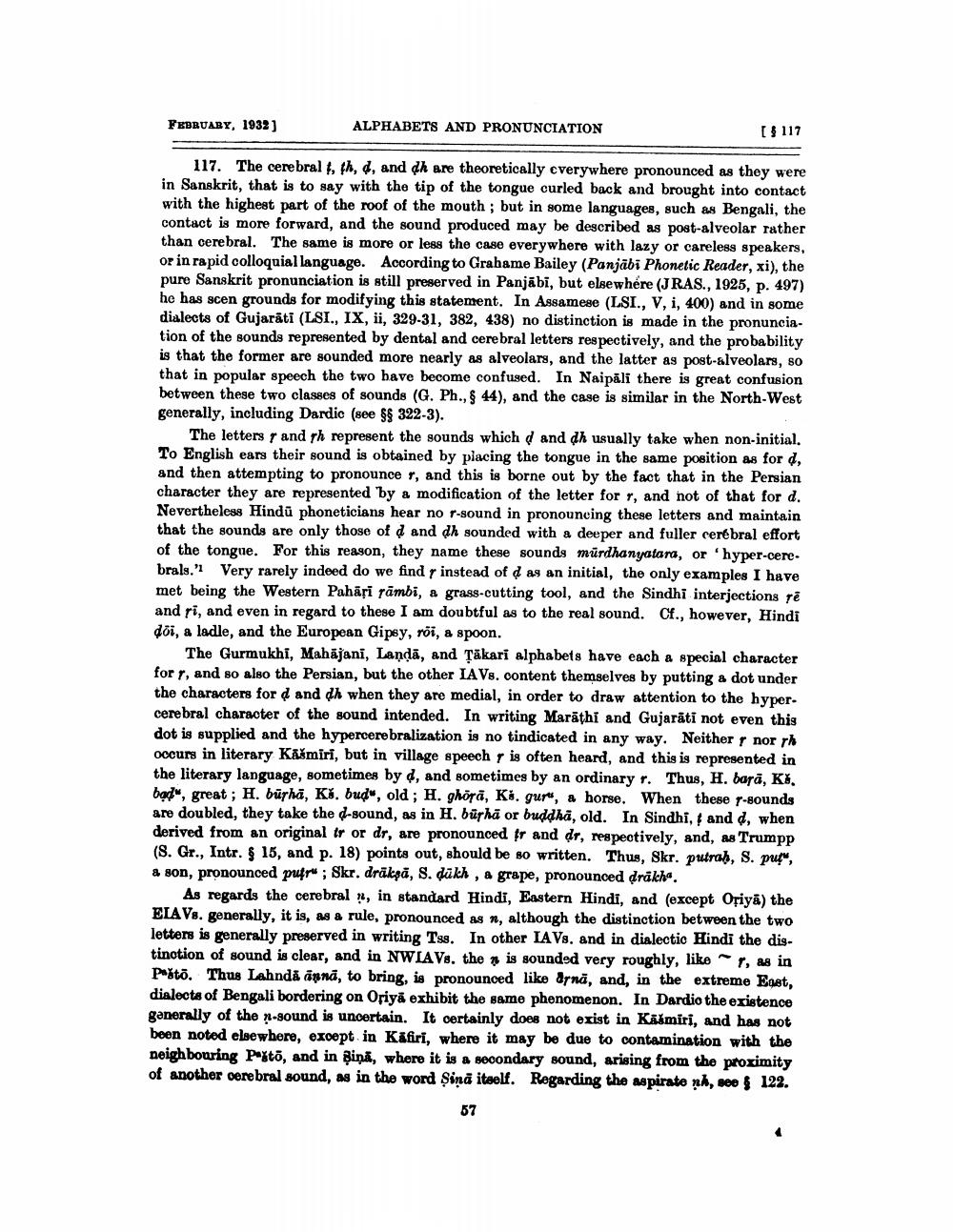________________
FEBRUABY, 1932)
ALPHABETS AND PRONUNCIATION
[
117
117. The cerebralt, th, d, and dh are theoretically everywhere pronounced as they were in Sanskrit, that is to say with the tip of the tongue curled back and brought into contact with the highest part of the roof of the mouth; but in some languages, such as Bengali, the contact is more forward, and the sound produced may be described as post-alveolar rather than cerebral. The same is more or less the case everywhere with lazy or careless speakers, or in rapid colloquial language. According to Grahame Bailey (Panjābi Phonetic Reader, xi), the pure Sanskrit pronunciation is still preserved in Panjabi, but elsewhere (JRAS., 1925, p. 497) he has scen grounds for modifying this statement. In Assamese (LSI., V, i, 400) and in some dialects of Gujarati (LSI., IX, ii, 329-31, 382, 438) no distinction is made in the pronunciation of the sounds represented by dental and cerebral letters respectively, and the probability is that the former are sounded more nearly as alveolars, and the latter as post-alveolars, so that in popular speech the two have become confused. In Naipāli there is great confusion between these two classes of sounds (G. Ph., § 44), and the case is similar in the North-West generally, including Dardic (see $$ 322-3).
The letters r and th represent the sounds which d and dh usually take when non-initial. To English ears their sound is obtained by placing the tongue in the same position as ford, and then attempting to pronouncer, and this is borne out by the fact that in the Persian character they are represented by a modification of the letter for , and not of that for d. Nevertheless Hindū phoneticians hear no r-sound in pronouncing these letters and maintain that the sounds are only those of d and dh sounded with a deeper and fuller cerebral effort of the tongue. For this reason, they name these sounds murdhanyatana, or 'hyper-cere. brals. Very rarely indeed do we find r instead of d as an initial, the only examples I have met being the Western Pahari rāmbi, a grass-cutting tool, and the Sindhi interjections rē and ri, and even in regard to these I am doubtful as to the real sound. Cf., however, Hindi dõi, a ladle, and the European Gipsy, roi, a spoon.
The Gurmukhi, Mahājani, Landa, and sākari alphabets have each a special character for r, and so also the Persian, but the other LAV8. content themselves by putting & dot under the characters for d and dh when they are medial, in order to draw attention to the hyper. cerebral character of the sound intended. In writing Marāthi and Gujarāti not even this dot is supplied and the hypercerebralization is no tindicated in any way. Neither nor sh occurs in literary Kašmiri, but in village speech is often heard, and this is represented in the literary language, sometimes by d, and sometimes by an ordinary r. Thus, H. barā, Kš. bad", great ; H. bürha, Kč. bud", old; H. ghörā, Ko. gurt, a horse. When these r-sounds are doubled, they take the d-sound, as in H. būshū or buddha, old. In Sindhi, 6 and d, when derived from an original ir or dr, are pronounced fr and dr, respectively, and, as Trumpp (S. Gr., Intr. & 15, and p. 18) points out, should be so written. Thus, Skr. putrah, S. put", a son, pronounced putru ; Skr. drāksă, S. dukh , a grape, pronounced drākha.
As regards the cerebral », in standard Hindi, Eastern Hindi, and (except Osiya) the ELAVs. generally, it is, as a rule, pronounced as n, although the distinction between the two letters is generally preserved in writing Tss. In other IAVs, and in dialectic Hindi the distinotion of sound is clear, and in NWLAVA. then is sounded very roughly, like 1, as in Pašto. Thus Lahndă apna, to bring, is pronounced like arna, and, in the extreme East, dialects of Bengali bordering on Oriya exhibit the same phenomenon. In Dardio the existence ganerally of the x-sound is uncertain. It certainly does not exist in Kasmiri, and has not been notod elsewhore, except in Käfiri, where it may be due to oontamination with the neighbouring Pexto, and in ßina, where it is a secondary sound, arising from the proximity of another cerebral sound, as in the word Şina itself. Regarding the aspirate xh, see 122.
57




